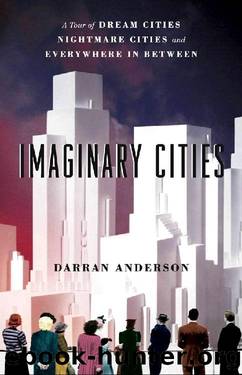Imaginary Cities_A Tour of Dream Cities, Nightmare Cities, and Everywhere in Between by Darran Anderson

Author:Darran Anderson [Anderson, Darran]
Language: eng
Format: epub
Publisher: University of Chicago Press
Published: 2017-04-06T04:00:00+00:00
Sealess Ships, Grounded Spacecraft and the Curse of the Genie
The problem with the future is not simply that it does not come true but that it sometimes does. Fred McNabbâs charming 1956 prediction âThis is your futureâ offers a material utopia that was largely achieved by the middle-classes of the First World. Flat screen 3-D televisions, moving staircases, microwave ovens, glass walls, slide-back roofs and Photo-vision Receivers are there for the purchasing, even if the helipads and ultra-sonic laundry remain elusive. Yet these things seem so tawdry, hollow and duplicitous as to make the title more a threat than a promise. âCivilisation transforms the object world into an extension of manâs mind and body . . .â Marcuse wrote. âThe people recognise themselves in their commodities; they find their soul in their automobile, hi-fi set, split-level home, kitchen equipment. The very mechanism which ties the individual to his society has changed, and social control is anchored in the new needs which it has produced.â64 You are what you own.
In Doddâs The Republic of the Future, innovations in technology and advances in rights produce an unsatisfied listlessness:
âFor a traveller, bent on a pleasure trip, machinery as a substitute for a garrulous landlord, and a score of servants, however bad, is found to be a poor and somewhat monotonous companion. I amuse myself, however, with perpetually testing all the bells and the electrical apparatus, calling for a hundred things I donât want, to see whether they will come through the ceiling or up the floor.â
The buildings âare all architecturally tasteless, as utility has been the only feature considered in their construction [. . .] this modern city is the very acme of dreariness. It is the monotony I think, which chiefly depresses me. It is not that the houses do not seem comfortable, clean and orderly, for all these virtues they possess. But fancy seeing miles upon miles of little two-story houses!â
The author is clear about what the problem is: âFreedom is the ability to live dangerously, inefficientlyâ. His reasons for this however would be laughable were he not serious; an axis of Irish anarchist dynamiters, Machiavellian Germans and feminists (âthere is not even a servant to welcome the master with a smileâ) brought about this age of pellet food, two hour working days and Ethical Temples65. The value of such a hysterical account is that it is just that; it provides a telling indication of contemporary neurosis and who the targets/threats were.
For all the innovations and lateral thinking, it seems remarkably and contemptibly difficult for many to envisage any other future for the female half of our species than ongoing domestic servitude, discrimination and harassment. The 1950s seem a golden age for this combination of Futurism and Neanderthalism. Better Homes and Gardens in September 1958 boasted âSix idea homes of the year!â complete with a gleaming cartoon with the byline, âWhat does a woman do all day?â It is a question and scene repeated ad nauseam. In Pathé footage from 1939,
Download
This site does not store any files on its server. We only index and link to content provided by other sites. Please contact the content providers to delete copyright contents if any and email us, we'll remove relevant links or contents immediately.
Kathy Andrews Collection by Kathy Andrews(11678)
The remains of the day by Kazuo Ishiguro(8746)
Paper Towns by Green John(5024)
Spare by Prince Harry The Duke of Sussex(4996)
The Body: A Guide for Occupants by Bill Bryson(4887)
Industrial Automation from Scratch: A hands-on guide to using sensors, actuators, PLCs, HMIs, and SCADA to automate industrial processes by Olushola Akande(4846)
Machine Learning at Scale with H2O by Gregory Keys | David Whiting(3970)
Be in a Treehouse by Pete Nelson(3876)
Harry Potter and the Goblet Of Fire by J.K. Rowling(3737)
Never by Ken Follett(3703)
Goodbye Paradise(3666)
Into Thin Air by Jon Krakauer(3261)
The Remains of the Day by Kazuo Ishiguro(3254)
The Cellar by Natasha Preston(3219)
The Genius of Japanese Carpentry by Azby Brown(3189)
Fairy Tale by Stephen King(3156)
120 Days of Sodom by Marquis de Sade(3118)
Drawing Shortcuts: Developing Quick Drawing Skills Using Today's Technology by Leggitt Jim(2960)
The Man Who Died Twice by Richard Osman(2955)
